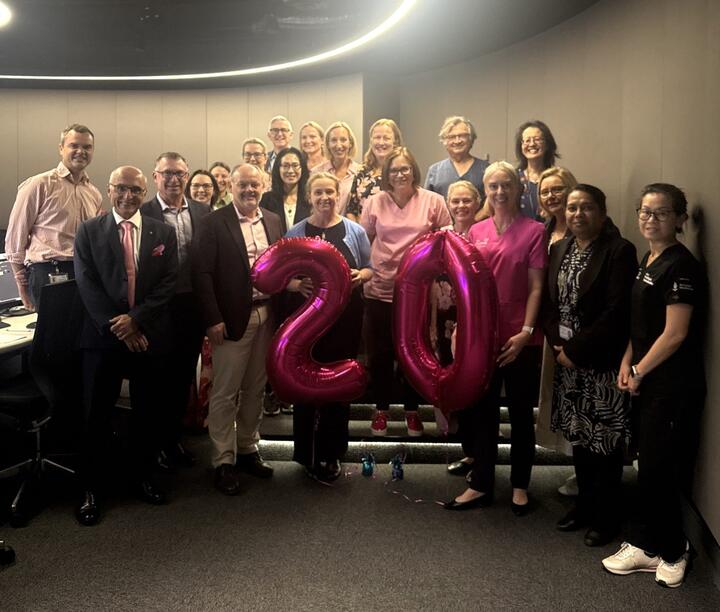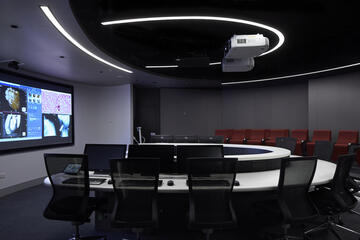Sydney Adventist Hospital recently celebrated 20 years of the success of its multidisciplinary teams (MDTs), a vital safety net of health professionals put in place to help cancer patients.
New South Wales' largest private hospital – also known as the San – was one of the early adopters of the MDT concept.
It now has 11 teams for 11 different cancer streams.
The teams meet regularly to donate their skills and experience towards each patient's unique cancer journey, from diagnosis through to treatment, recovery and survivorship.
Professor Michael Hughes, surgical oncologist and Chair of Breast MDT at the San, said the system delivered the best care and was inclusive of the patients in treatment decisions.
"This approach focuses on the whole individual and demonstrates empathy for our patients and their families," he said.
"In these MDT meetings, clinicians review the diagnostic information, the clinical presentation and the relevant medical and psychosocial issues.
"We discuss different viewpoints and the most up-to-date research, clinical trials, and evidence-based treatment approaches.
"The person's treating clinician then takes the recommendations from the MDT to the patient for discussion, and the patient is involved in the final decision-making process.
"This way the patient can benefit from the input of multiple specialists – at no extra cost – and without having to go from one doctor to another."
How patients benefit from MDTs
At the San, multidisciplinary teams meet in a purpose-built mini-auditorium, dubbed the cancer 'war room'.
The teams donate hundreds of hours of their time to attend meetings, which start at 7am, before their workday begins. Some specialists attend six MDT meetings each fortnight, for different cancer streams.
Clinical Professor Gavin Marx, medical oncologist and Director of the San Integrated Cancer Centre, said the MDTs facilitated a smooth transition across the specialties for each patient.
"The multidisciplinary team meetings include surgeons, medical oncologists, radiation oncologists, pathology, imaging/radiology, cancer nurse-navigators and allied health," he said.
"It is also a great quality-assurance process, which patients appreciate."
Radiation oncologist Professor John Boyages agreed, calling the MDTs "a real safety net".
"And that is important," he said.
"If you're worried about something with one of your patients, you can bring it to the whole group. Patients appreciate that."
Moving to 'the next level'
MDT meetings have come a long way since starting at the San in 2005.
In those days, multidisciplinary teams met in the hospital boardroom, with paper copies of everything and x-ray films viewed on a portable lightbox wheeled into the room.
"In 2017, thanks to the exceptional generosity of the Gates family, a purpose-built, high-tech MDT facility opened at the San," Prof Marx said.
"This, combined with the development of a dedicated cancer information management system, funded through the San Foundation, took MDTs to the next level at the San.
"The cancer information management system not only enhances timeliness, accuracy and the smooth running of the meetings, it provides data for research projects which, in turn, leads to continual improvements in cancer treatments and care for our patients.
"The concept of multidisciplinary care is well-recognised as the gold standard for optimising patient care in the cancer setting.
"We are very fortunate at the San, a hospital that is very supportive and provides good resources to make MDTs possible."
Prof Boyages said a cancer diagnosis came with an "avalanche of information" for patients.
"The San's multidisciplinary teams are truly integrated, collegiate and respectful," he said.
"By working together, we review and visualise each patient's imaging, nuclear studies, and histopathology in detail.
"This allows us to provide patients with a clear, coordinated treatment strategy without the 'specialist ping-pong' so common elsewhere. It's teamwork at its very best, and patients and their families benefit.
"The MDTs involve a whole spectrum of expertise, and we're not just focused on the period of active treatment, it's also about picking up the pieces afterwards, which is important."
Focus for the future
The 11 MDTs at the San cover a wide range of specialties: breast; gastrointestinal; neuro-oncology; lung; urology; melanoma, sarcoma, head and neck cancer; haematology; endocrinology; gynaecological oncology; and prostate.
"The focus for the immediate future is to build the capacity for improved data management," Prof Marx said.
"This will enable the San's multiple MDT cancer streams to collaborate with other centres in cancer research, and to contribute to national cancer data.
"This will require a combination of extra data-managers and optimising our cancer information system to enable the San to contribute to, and participate in, more research. This will provide even better outcomes for patients."
Associate Professor Stephen Pillinger, Chair of the Gastrointestinal MDT, said all cancer cases should be discussed collectively for the patient's benefit.
"MDTs ensure cancer is managed not by one physician, but by a whole oncological team, providing clinical oversight and consistency," he said.
"It gives patients reassurance that the latest research is taken into account, that all treatment options are considered until consensus is reached on the best pathway, and that cancer care is being conducted in the most thorough and up-to-date manner possible."
Read more: Learning calm in the chaos of Emergency Care
Read more: Seven in a row: San centre tops NSW patient survey
Next Safety And Quality:
6/11/2025 New $3.2m chemo suite boosts Perth cancer services
Previous Safety And Quality:
21/10/2025 High-tech new facility to elevate cancer care in Victoria
![[APHA]](/images/logo_apha.svg)

